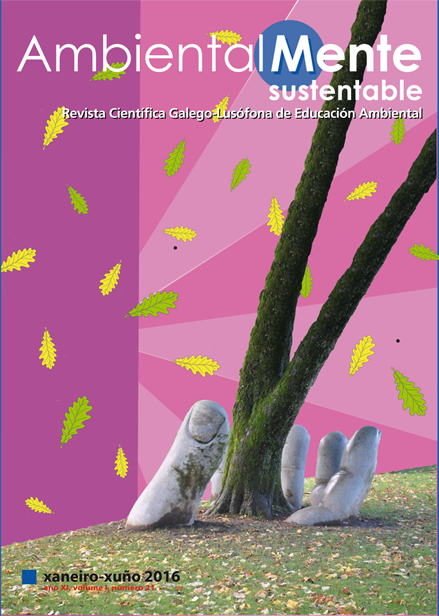A sacralidade e a conservação da Serra de Gorongosa: uma alternativa para a prática de Educação Ambiental
DOI:
https://doi.org/10.17979/ams.2016.01.021.1838Palavras-chave:
sagrado, sacracidade, régulo, educação ambientalResumo
A pesquisa a ser apresentada no III Congresso Internacional da Educação Ambiental enquadra-se no eixo temático: Educação Ambiental, Interpretação e Conservação e, descreve as potencialidades da Serra de Gorongosa para a prática de Educação resultantes da adopção, pelas comunidades locais, de mecanismos tradicionais de controlo de conduta dos seus membros que os leva a desenvolverem acções historicamente conducentes à conservação de alguns ecossistemas na Serra de Gorongosa. A pesquisa pretende apresentar alguns procedimentos de realização de aula de campo para a prática de Educação Ambiental, tendo como recurso didáctico a Serra de Gorongosa. Uma das grandes dificuldades da escola moçambicana consiste em dar uma formação integral ao cidadão para que este adquira e desenvolva conhecimentos e capacidades intelectuais, físicas e uma educação politécnica, estética e ética, sem precisar negar as especificidades culturais e a identidade dos grupos que compõe a sociedade moçambicana. Para a realização desta pesquisa foi administrado entrevista a quatro chefes de família, um em cada comunidade. Também fez-se a observação do quotidiano de vinte famílias, num período de duas semanas. A pesquisa permitiu compreender que os tabús e as práticas mágico-religiosas possuem uma estreita ligação com os lugares sagrados e a função cultural, tal relação manifesta-se pela simbologia, pela linguagem, pelos conceitos e termos típicos da comunidade, manipulados pelo régulo e seus seguidores. Deste modo, os diferentes ecossistemas adquirem um valor sagrado e um significado simbólico próprio. Assim, a serra pode se constituir em sistema que permita aos alunos, de diferentes níveis escolares, estabelecerem a ligação entre a teoria e a prática, desenvolverem o valor afectivo e, por esta razão, assumir um papel relevante na Educação Ambiental.
Downloads
Referências
Bernardi, Bernardo. Introdução aos estudos etno–antropológicos. Edições 70, Lisboa 1974.
Boletim da República. Lei nº 6/92 de 6 de Maio, Sistema Nacional de Educação. I Série, número 19.
Boletim da República. Diploma Ministerial nº 61/2003 de 11 de Junho, Regulamento do Ensino Secundário Geral. I Série, número 24.
Conti, José Bueno, Contos de Campo in: Geografia: Práticas de Campo, Laboratório e Sala de Aula, Editora Sarandi/Luis António Bittar Venturi (organizador), São Paulo, 2011.
Ferro, B.P.A. e D. Bouman. Notícia Explicativa da Carta Hidrogeológica na Escala 1:1.000.000: Projecto da Carta Hidrológica de Moçambique com Apoio da UNICEF. Ministério da Construção e Águas, Direcção Nacional de Águas, Moçambique, 1987.
Invez, Romeu e Ferraz de Freitas, o Grupo Sena, Gabinete Provincial de Acção Psicológica. Lourenço Marques 1971.
Junod, Henri. Usos e costumes dos Bantus, Tomo II, Arquivo Histórico de Moçambique, Documento 3, Maputo , 1996.
Leff, Enrique. Ecologia, Capital e Cultura: A Territorialização da Racionalidade Ambiental. Editora Vozes, Rio de Janeiro, Brasil, 2009.
Leff, Enrique. Saber Ambiental: Sustentabilidade, Racionalidade, Complexidade, Poder. Editora Vozes, Rio de Janeiro, Brasil, 2013.
Mafalacusser, J.M. e M.R. Marques. O Potencial dos Recursos Agrários do Distrito de Gorongosa e Possibilidades de Desenvolvimento: Programa de Desenvolvimento Rural, Sofala. Direcção Provincial de Agricultura e Desenvolvimento Rural de Sofala, Moçambique, PRODER, 2000.
Mulhaisse, Raimundo Alberto. A Avaliação da Influência do Discurso Ambiental Curricular Das Comunidades Locais Do Distrito de Dondo-Moçambique, Dissertação do Mestrado, Pontifícia Universidade Católica de São Paulo, em Convénio com a Universidade Pedagógica Moçambique, 2006.
Rosendahl, Zeny. O Sagrado e sua Dimensão Espacial in Olhares Geográficos: Modos de ver e viver o Espaço, Castro, Iná Elias, Paulo César da Costa Gomes e Roberto Lobato Corrêa. Rio de Janeiro, Editora Bertrand Brasil Lda., 2012.
Sotratti, Marcelo António e MARAFON, Glaucio José Pesquisa Qualitativa nos Estudos do Património Cultural em Espaços Rurais: Desafios e Possibilidades In: Geografia: Práticas de Campo, Laboratório e Sala de Aula, Editora Sarandi/Luis António Bittar Venturi (organizador), São Paulo, 2011.
Venturi, Luis António Bittar. Geografia: Práticas de Campo, Laboratório e Sala de Aula, Editora Sarandi, São Paulo, 2011.
Documentos Oficiais:
Boletim da República. Lei nº 6/92 de 6 de Maio, Sistema Nacional de Educação. I Série –número 19.
Boletim da República. Diploma Ministerial nº61/2003 de 11 de Junho, Regulamento do Ensino Secundário Geral. I Série, número 24.
WWF, Povos Indígenas e Conservação Ambiental: a Declaração de Princípios da Rede WWF. Edição WWF Internacional, Suíça, 2008.
Wikipédia, a enciclopédia livre: http://pt.wikipedia.org/wiki/Gorongosa, Acessado no dia 28 de Maio de 2015.
Downloads
Publicado
Edição
Secção
Licença
Os traballos publicados nesta revista están baixo unha licenza Creative Commons Recoñecemento-CompartirIgual 4.0 Internacional.
Permitese e anímase aos autores a difundir os artigos aceptados para a súa publicación nos sitios web persoais ou institucionais, antes e despois da súa publicación, sempre que se indique claramente que o traballo pertence a esta revista e se proporcionen os datos bibliográficos completos xunto co acceso ao documento.



